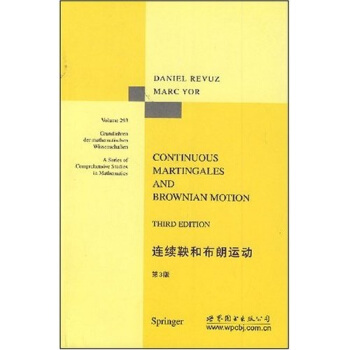![群论导论(第4版)(英文版) [An Introduction to the Theory of Groups]](https://pic.qciss.net/10184591/0899ce80-e4c2-49b6-9e6f-4daa065c4793.jpg)
承接 住宅 自建房 室内改造 装修设计 免费咨询 QQ:624617358 一级注册建筑师 亲自为您回答、经验丰富,价格亲民。无论项目大小,都全力服务。期待合作,欢迎咨询!QQ:624617358

出版社: 世界图书出版公司
ISBN:9787510004988
版次:1
商品编码:10184591
包装:平装
外文名称:An Introduction to the Theory of Groups
开本:24开
出版时间:2009-08-01
用纸:胶版纸
页数:513
正文语种:英语
具体描述
内容简介
《群论导论(第4版)(英文版)》介绍了:Group Theory is a vast subject and, in this Introduction (as well as in theearlier editions), I have tried to select important and representative theoremsand to organize them in a coherent way. Proofs must be clear, and examplesshould illustrate theorems and also explain the presence of restrictive hypo-theses. ! also believe that some history should be given so that one canunderstand the origin of problems and the context in which the subjectdeveloped. Just as each of the earlier editions differs from the previous one in a signifi-cant way, the present (fourth) edition is genuinely different from the third.Indeed, this is already apparent in the Table of Contents. The book nowbegins with the unique factorization of permutations into disjoint cycles andthe parity of permutations; only then is the idea of group introduced. This isconsistent with the history of Group Theory, for these first results on permu-tations can be found in an 1815 paper by Cauchy, whereas groups of permu-tations were not introduced until 1831 (by Galois)But even if history目录
Preface to the Fourth EditionFrom Preface to the Third Edition
To the Reader
CHAPTER 1 Groups and Homomorphisms
Permutations
Cycles
Factorization into Disjoint Cycles
Even and Odd Permutations
Semigroups
Groups
Homomorphisms
CHAPTER 2 The Isomorphism Theorems
Subgroups
Lagranges Theorem
Cycic Groups
Normal Subgroups
Quotient Groups
The Isomorphism Theorems
Correspondence Theorem
Direct Products
CHAPTER 3 Symmetric Groups and G-Sets
Conjugates
Symmetric Groups
The Simplicity of A.
Some Representation Theorems
G-Sets
Counting Orbits
Some Geometry
CHAPTER 4 The Sylow Theorems
p-Groups
The Sylow Theorems
Groups of Small Order
CHAPTER 5 Normal Series
Some Galois Theory
The Jordan-Ho1der Theorem
Solvable Groups
Two Theorems of P. Hall
Central Series and Nilpotent Groups
p-Groups
CHAPTER 6 Finite Direct Products
The Basis Theorem
The Fundamental Theorem of Finite Abelian Groups
Canonical Forms; Existence
Canonical Forms; Uniqueness
The KrulI-Schmidt Theorem
Operator Groups
CHAPTER 7 Extensions and Cohomology
The Extension Problem
Automorphism Groups
Semidirect Products
Wreath Products
Factor Sets
Theorems of Schur-Zassenhaus and GaschiJtz
Transfer and Burnsides Theorem
Projective Representations and the Schur Multiplier
Derivations
CHAPTER 8
Some Simple Linear Groups
Finite Fields
The General Linear Group
PSL(2, K)
PSL(m, K)
Classical Groups
CHAPTER 9
Permutations and the Mathieu Groups
Multiple Transitivity
Primitive G-Sets
Simplicity Criteria
Atline Geometry
Projeetive Geometry
Sharply 3-Transitive Groups
Mathieu Groups
Steiner Systems
CHAPTER 10
Abelian Groups
Basics
Free Abelian Groups
Finitely Generated Abelian Groups
Divisible and Reduced Groups
Torsion Groups
Subgroups of
Character Groups
CHAPTER 11
Free Groups and Free Products
Generators and Relations
Semigroup Interlude
Coset Enumeration
Presentations and the Schur Multiplier
Fundamental Groups of Complexes
Tietzes Theorem
Covering Complexes
The Nielsen Schreier Theorem
Free Products
The Kurosh Theorem
The van Kampen Theorem
Amalgams
HNN Extensions
CHAPTER 12
The Word Problem
Introduction
Turing Machines
The Markov-Post Theorem
The Novikov-Boone-Britton Theorem: Sufficiency of Boones
Lemma
Cancellation Diagrams
The Novikov-Boone-Britton Theorem: Necessity of Boones
Lemma
The Higman Imbedding Theorem
Some Applications
Epilogue
APPENDIX I
Some Major Algebraic Systems
APPENDIX II
Equivalence Relations and Equivalence Classes
APPENDIX Ill
Functions
APPENDIX IV
Zorns Lemma
APPENDIX V
Countability
APPENDIX VI
Commutative Rings
Bibliography
Notation
Index
前言/序言
Group Theory is a vast subject and, in this Introduction (as well as in theearlier editions), I have tried to select important and representative theoremsand to organize them in a coherent way. Proofs must be clear, and examplesshould illustrate theorems and also explain the presence of restrictive hypo-theses. ! also believe that some history should be given so that one canunderstand the origin of problems and the context in which the subjectdeveloped. Just as each of the earlier editions differs from the previous one in a signifi-cant way, the present (fourth) edition is genuinely different from the third.Indeed, this is already apparent in the Table of Contents. The book nowbegins with the unique factorization of permutations into disjoint cycles andthe parity of permutations; only then is the idea of group introduced. This isconsistent with the history of Group Theory, for these first results on permu-tations can be found in an 1815 paper by Cauchy, whereas groups of permu-tations were not introduced until 1831 (by Galois)But even if history wereotherwise, I feel that it is usually good pedagogy to introduce a generalnotion only after becoming comfortable with an important special case. Ihave also added several new sections, and I have subtracted the chapter onHomologieal Algebra (although the section on Horn functors and charactergroups has been retained) and the section on Grothendieck groups. The format of the book has been changed a bit: almost all exercises nowoccur at ends of sections, so as not to interrupt the exposition. There areseveral notational changes from earlier editions: I now write insteadof to denote "H is a subgroup of G"; the dihedral group of order2n is now denoted by instead of by ; the trivial group is denoted by !instead of by {1}; in the discussion of simple linear groups, I now distinguishelementary traesvections from more general transvections;用户评价
评分
不错不错 易学易懂 适合初学者
评分我有一头小毛驴我从来都不骑有一天我心血来潮骑着去赶集
评分此用户未填写评价内容
评分此用户未填写评价内容
评分618買的。還沒看,估計不錯,GTM的很好。
评分送货快,图书质量好。
评分配送快!!赞!!!
评分我有一头小毛驴我从来都不骑有一天我心血来潮骑着去赶集
评分不错不错 易学易懂 适合初学者
相关图书
本站所有内容均为互联网搜索引擎提供的公开搜索信息,本站不存储任何数据与内容,任何内容与数据均与本站无关,如有需要请联系相关搜索引擎包括但不限于百度,google,bing,sogou 等
© 2025 book.qciss.net All Rights Reserved. 图书大百科 版权所有

![超颖材料电动力学(影印版) [ELECTRODYNAMICS OF METAMATERIALS] pdf epub mobi 电子书 下载](https://pic.qciss.net/11114418/rBEGF1CZ5iAIAAAAAAArezuIe4oAAAZGAB8aaAAACuT116.jpg)
![流形、张量分析和应用(第2版) [Manifollds, Tensor Analysis, and Applications 2nd ed] pdf epub mobi 电子书 下载](https://pic.qciss.net/11483421/53a8c88bNd5252fe2.jpg)


![几何不变量理论(第3版)(英文版) [Geometric Invariant Theory Third Enlarged Edition] pdf epub mobi 电子书 下载](https://pic.qciss.net/11110551/rBEHaVCN4uEIAAAAAACKifEgRWUAAChTAAN4Z8AAIqh002.jpg)


![复几何导论(英文版) [Complex Geomety:An Introduction] pdf epub mobi 电子书 下载](https://pic.qciss.net/10184579/a9d59eae-0262-48e0-a4ae-d619b4c2d831.jpg)
![同调代数 [Homological Algebra] pdf epub mobi 电子书 下载](https://pic.qciss.net/10914295/22c00bb7-475a-493d-988e-0bea7915231f.jpg)



![代数拓扑导论 [Algebraic Topology:An Introduction] pdf epub mobi 电子书 下载](https://pic.qciss.net/10184569/1f2691de-8ab9-42ef-a71c-ae5295276dec.jpg)

![经典数学丛书(影印版):抽象调和分析·第1卷(第2版) [Abstract Harmonic Analysis Ⅰ] pdf epub mobi 电子书 下载](https://pic.qciss.net/11551547/5438761cN3a144fab.jpg)



![应用泛函分析(第2卷)(英文版) [Applied Functional AnalysisMa:In Principles and Their Applications] pdf epub mobi 电子书 下载](https://pic.qciss.net/10104517/2f5abac2-6427-4f25-b218-91904c287192.jpg)
![基础数论(英文版) [Basic Number Theory] pdf epub mobi 电子书 下载](https://pic.qciss.net/10184575/af663a0f-1dcd-436b-b472-36efed609e5f.jpg)